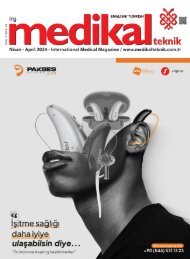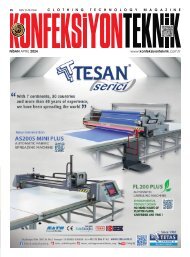You also want an ePaper? Increase the reach of your titles
YUMPU automatically turns print PDFs into web optimized ePapers that Google loves.
41
the cab and the body match. The stripes are then painted and
dried, and the masking removed.
• 8 The front and rear bumpers, which are not painted, are then
installed. If the mirrors have been removed to paint the stripes,
they are reinstalled.
Finishing the body
• 9 The electrical wiring in the body walls and ceiling is installed
from the inside, and foam panels are bonded in place to provide
thermal and noise insulation. With the wiring in place, the exterior
lights are mounted and connected, and the exterior latches, grab
handles, windows, and other trim pieces are installed.
• 10 The oxygen piping and outlets, which are part of the patient
life-support system, are installed in the body walls. The vacuum
system, which removes blood, saliva, and other body fluids is also
installed. If the ambulance body requires an auxiliary heating and
air-conditioning system, it is installed at this time.
•11 With all the systems in place, the interior cabinets are installed
and the walls, floors, and ceilings are covered. The electrical
power distribution board is installed in a forward compartment
of the body and the panel is connected to the cab and chassis
electrical wiring. If the ambulance is specified with an inverter,
which converts 12 volts direct current from the vehicle batteries
into 120 volts altemating current for use with certain medical
equipment, it is also installed at this time.
• 12 The seats and upholstery pieces, which are either purchased
or assembled in a separate area, are fastened in place. The
interior grab handles, containers, and trim pieces are installed as
the final step.
Quality Control
The design of ambulances is regulated by several standards,
and the manufacturer must take appropriate steps to ensure
compliance with those standards. Each system is inspected
and tested for proper installation and operation as part of the
manufacturing process. In addition, every material, from the
aluminum in the body to the foam in the head rests, is certified by
the manufacturer to meet the required specifications.
The Future
Many fire departments are finding that approximately 80-90%
of their calls are for medical emergencies, while only 10-20%
are for fires. In the case of medical emergencies, an ambulance
has to be called in addition to the fire engine. Instead of
responding to all calls with large pumpers or ladder trucks, some
fire departments are starting to use smaller, lower-cost firstresponse
vehicles that combine the equipment and patient
transport capabilities of a rescue truck and ambulance
with the fire suppression capabilities of a small pumper.
These combination vehicles are able to handle a variety of
emergency situations, including those involving small fires
such as might occur in vehicle accidents. This saves wear on
the larger firefighting vehicles, and eliminates the need to
dispatch two vehicles to the same incident. In the future, an
increase in traffic congestion and an increase in the average
age of the population in the United States are expected to
increase the number of medical emergency calls. When this
happens, it is expected that the single-function ambulance
may be replaced by a multi-function combination vehicle in
many areas.
Aralık 2019

















